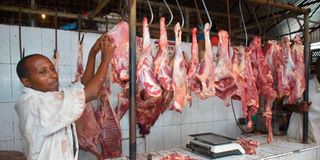Premium
From poultry to pigs, know the meat to invest in for good profits

Joseph Muinde sells goat meat at Marikiti market in Mombasa County on December 23, 2019.
The meat industry is one of the fast-growing segments of the agriculture sector, driven by rising human population, urbanisation and improving household incomes.
Meat production accounts for over three-quarters of the output in the livestock sub-sector. It engages about 40 per cent of households in Kenya, which keep livestock that is eventually slaughtered for meat.
According to the Statistics Unit of the State Department of Livestock, Kenya’s 50 million people rely on a population pool of 19.6 million cattle, 27.3 million sheep, 35 million goats and 4.8 million camels for red meat.
White meat is supplied from 600,000 pigs, 730,000 rabbits and poultry, which comprises 46 million indigenous chickens, 5.6 million exotic layers, 4.9 million exotic broilers and 1.2 million other related species.
Semi-arid areas
More than half of the ruminant livestock (60 per cent) is found in the arid and semi-arid areas (Asal), employing more than 90 per cent of the population.
Cattle provide beef; sheep mutton; goats chevon; poultry chicken; pigs pork and camels, donkeys and rabbits give camel meat, donkey meat and rabbit meat.
Further classification depends on the animal's age and the specific section where the cut is made.
For instance, veal is meat from newborn calves (primarily male), and rump steak is a cut from the rump of cattle.
The country currently produces some 756,000 metric tonnes of meat, comprising 658,000 metric tonnes (MT) of red meat from the ruminants (cattle, sheep, goats and camels) and 98,000 metric tonnes (MT) of white meat (poultry, rabbits and pigs).
National demand
Kenyans consume an average of 16kg of beef per capita annually, creating a total national demand of 800,000MT of red meat per year, indicating a rising deficit of supply from production.
Beef is the most important red meat, accounting for 70 per cent of the product, while sheep and goats 28 per cent and camels 2 per cent. To provide this volume of red meat, close to three million heads of cattle and 10 million sheep and goats are slaughtered annually.
This implies that we consume about 15 per cent of our cattle herd annually and 16 per cent of our sheep and goat (shoat) flock. Our beef production is 528,000MT, whereby Asals give 370,000MT of beef and dairy culls 158,400MT.
The number of cattle slaughtered for beef has been on a steady increase of 7.4 per cent annually to the current figure.
From the sheep population of 27.2 million heads, we produce 50,810MT of mutton. The goat flock of 35 million heads produces 50,500MT of chevon.
The current per capita consumption of chevon and mutton is 0.76kg and 0.5kg, respectively. To meet the resultant demand, the population of sheep and goats has to grow two-fold.
The 2019 census puts camels at 4.8 million. Besides meat production, estimated at 57,569MT, camels are the primary source of livelihood for pastoralists.
The poultry industry, on the other hand, is one of the fastest growing (registers 6 per cent growth every year) as it is a pro-poor livestock enterprise.
The annual poultry meat production is 88 million metric tonnes. Chickens constitute 98 per cent of the total poultry population, while other species like ducks, turkeys, pigeons, ostriches, guinea fowls and quails account for 2 per cent.
372 million broilers
Poultry consumption stands at 76,135MT based on a per capita consumption of 2.4kg, against the recommended 12kg as per the World Health Organisation. Projected poultry meat consumption by 2030 will be 797,995MT. This volume is expected to be raised by 372 million broilers producing 557,997MT and 1.5 billion indigenous chicken producing 239,398MT.
Some of the challenges that may hinder the growth of the poultry industry are loss of genetic diversity in indigenous chickens, inadequate processing facilities, poor marketing infrastructure and high prevalence of diseases.
The pigs' industry is in the hands of small-scale farmers (70 per cent), who keep 595,631 animals producing 14,440MT. The number of pigs slaughtered stands at 388,200 annually.
The current per capita consumption of pork stands at 0.4kg, against the recommended 0.8kg by WHO, projecting that an estimated 19,033MT of pork is required to meet the current demand.
By 2030, the projected demand would be 53,160MT while the projected population of pigs 1.2 million.
Rabbit meat annual production is estimated at 2,800MT. The industry's growth is constrained by inadequate housing, limited access to quality breeding stock, high cost and poor quality feeds.


